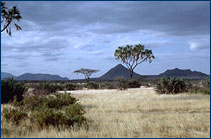Difference between revisions of "History 8 Human Origins Vocabulary"
| Line 13: | Line 13: | ||
'''sources''' | '''sources''' | ||
| − | <references/ | + | <references/ |
2. fossils | 2. fossils | ||
Revision as of 23:18, 15 September 2012
Return to Main Page History 8
Work must be supported with citation of source. Manual may be noted with CF Manual and page numbers). Any information from class notes may be cited as Class notes (date of lecture)or from a video Name of Video. You may not use Wikipedia as a source. Please sign your entry.
Vocabulary
1.australopithecines- Australopithecines were a genus of early hominoids that lived from about 5.6 MYA to about 1 million BC. [1] About 6 MYA, the jungles that covered Africa began to dry out, and food supply became low. In this situation, the human group was the least susceptible to survive, so they were forced out into the grassland. These early hominoids were forced to adapt. Examples: opposable thumbs and bipedal stance needed for throwing well, hip joints needed to change so that legs aligned with the backbone. Ankles became stronger and less flexible. Big toe became in alignment with the other toes, allowing it to take on the weight of the body. Also, the hole where the spinal column connects to the brain moved the the center of the skull, allowing the spinal cord to run perpendicular to the ground. End the end, the Australopithecines that did not adapt quick enough became extinct about 1 million B.C.[2]
-Emily Pedrick
sources <references/
2. fossils
3. bipeds/bipedalism
4. foramen magnum
5. cranium
6. savanna
The savanna is grassland scattered with shrubs and isolated trees. Savannas are found in warm to hot climates where the average rainfall is about 30-40 inches per year. They cover almost half the surface of Africa, as well as large portions of Australia, South America, and India. The soil of the savanna is porous, with rapid drainage of water. It has a thin layer of organic soil, called humus, which provides vegetation and nutrients. Savannas both have wet and dry seasons. The beginning of the dry season is indicated in October through series of violent thunderstorms and drying winds. Fires are prevalent throughout this season. In, March thunder storms drive again, this time signifying the start of the rainy season. [4] The savanna is the home to many different animals, including the African elephant, cheetah, gazelle, giraffe, and hippopotamus. [5] The savanna is an important biome for certain animals and the ecosystem.
Savanna in the Samburu Game Preserve, Kenya.
- Sources:
- ↑ http://www.iscid.org/encyclopedia/Australopithecines viewed 9/15/2012 ©2005
- ↑ CF Manual pages 20-21 viewed 9/15/2012
- ↑ http://zinjanthropus.wordpress.com/2008/11/10/intro-to-australopiths/ Viewed 9/14/2012, ©2008
- ↑ [1].
- ↑ [2].
- ↑ [3].
By Jeffrey Wang
7. hominid
8. Oldowan Tools
9. herbivores
10. marrow
11. sweating
12. panting
13. browridge
14. Acheulean tools
15. bifacial
16. interglacials
17. Sunda
18. Beringia
19. loess
20. mammoths
21. prepared core
22. permafrost
23. burial
24. grave goods
25. archaic
26. frontal lobe
27. Shamanism
28. micro-flints
29. brunishers
30. burins
31. blade and burin
32. annealing
33. composite tools
34. hafting
35. migrational
36. nomadic
37. atlatl
38. egalitarian
39. knapper
40. microlith
41. diffusionist
42. ochre
43.dentalium
44. middens
45. horticulture

